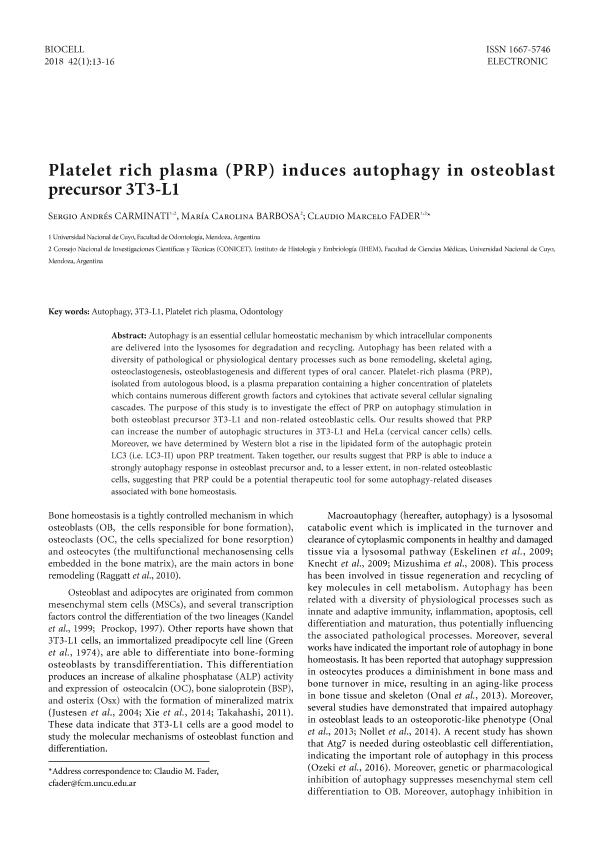Mostrar el registro sencillo del ítem
dc.contributor.author
Carminati, Sergio Andrés

dc.contributor.author
Barbosa, María Carolina

dc.contributor.author
Fader Kaiser, Claudio Marcelo

dc.date.available
2020-01-27T12:37:31Z
dc.date.issued
2018-10
dc.identifier.citation
Carminati, Sergio Andrés; Barbosa, María Carolina; Fader Kaiser, Claudio Marcelo; Platelet rich plasma (PRP) induces autophagy in osteoblast precursor 3T3-L1; Tech Science Press; Biocell; 42; 1; 10-2018; 13-16
dc.identifier.issn
0327-9545
dc.identifier.uri
http://hdl.handle.net/11336/95827
dc.description.abstract
Autophagy is an essential cellular homeostatic mechanism by which intracellular components are delivered into the lysosomes for degradation and recycling. Autophagy has been related with a diversity of pathological or physiological dentary processes such as bone remodeling, skeletal aging, osteoclastogenesis, osteoblastogenesis and different types of oral cancer. Platelet-rich plasma (PRP), isolated from autologous blood, is a plasma preparation containing a higher concentration of platelets which contains numerous different growth factors and cytokines that activate several cellular signaling cascades. The purpose of this study is to investigate the effect of PRP on autophagy stimulation in both osteoblast precursor 3T3-L1 and non-related osteoblastic cells. Our results showed that PRP can increase the number of autophagic structures in 3T3-L1 and HeLa (cervical cancer cells) cells. Moreover, we have determined by Western blot a rise in the lipidated form of the autophagic protein LC3 (i.e. LC3-II) upon PRP treatment. Taken together, our results suggest that PRP is able to induce a strongly autophagy response in osteoblast precursor and, to a lesser extent, in non-related osteoblastic cells, suggesting that PRP could be a potential therapeutic tool for some autophagy-related diseases associated with bone homeostasis.
dc.format
application/pdf
dc.language.iso
eng
dc.publisher
Tech Science Press

dc.rights
info:eu-repo/semantics/openAccess
dc.rights.uri
https://creativecommons.org/licenses/by-nc-sa/2.5/ar/
dc.subject
AUTOPHAGY
dc.subject
3T3-L1
dc.subject
PLATELET RICH PLASMA
dc.subject
ODONTOLOGY
dc.subject.classification
Bioquímica y Biología Molecular

dc.subject.classification
Ciencias Biológicas

dc.subject.classification
CIENCIAS NATURALES Y EXACTAS

dc.title
Platelet rich plasma (PRP) induces autophagy in osteoblast precursor 3T3-L1
dc.type
info:eu-repo/semantics/article
dc.type
info:ar-repo/semantics/artículo
dc.type
info:eu-repo/semantics/publishedVersion
dc.date.updated
2019-10-23T19:29:22Z
dc.identifier.eissn
1667-5746
dc.journal.volume
42
dc.journal.number
1
dc.journal.pagination
13-16
dc.journal.pais
Estados Unidos

dc.description.fil
Fil: Carminati, Sergio Andrés. Consejo Nacional de Investigaciones Científicas y Técnicas. Centro Científico Tecnológico Conicet - Mendoza. Instituto de Histología y Embriología de Mendoza Dr. Mario H. Burgos. Universidad Nacional de Cuyo. Facultad de Ciencias Médicas. Instituto de Histología y Embriología de Mendoza Dr. Mario H. Burgos; Argentina
dc.description.fil
Fil: Barbosa, María Carolina. Consejo Nacional de Investigaciones Científicas y Técnicas. Centro Científico Tecnológico Conicet - Mendoza. Instituto de Histología y Embriología de Mendoza Dr. Mario H. Burgos. Universidad Nacional de Cuyo. Facultad de Ciencias Médicas. Instituto de Histología y Embriología de Mendoza Dr. Mario H. Burgos; Argentina
dc.description.fil
Fil: Fader Kaiser, Claudio Marcelo. Consejo Nacional de Investigaciones Científicas y Técnicas. Centro Científico Tecnológico Conicet - Mendoza. Instituto de Histología y Embriología de Mendoza Dr. Mario H. Burgos. Universidad Nacional de Cuyo. Facultad de Ciencias Médicas. Instituto de Histología y Embriología de Mendoza Dr. Mario H. Burgos; Argentina
dc.journal.title
Biocell

dc.relation.alternativeid
info:eu-repo/semantics/altIdentifier/url/http://www.techscience.com/biocell/v42n1/33523
dc.relation.alternativeid
info:eu-repo/semantics/altIdentifier/doi/http://dx.doi.org/10.32604/biocell.2018.07008
Archivos asociados
